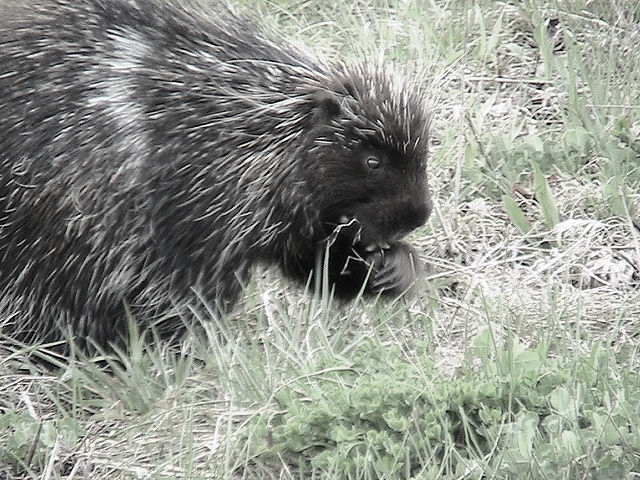We were trying to get a porcupine to fight the wild turkeys.
It started when Chris lobbed a Frisbee over my head and it sailed into the thicket of high grass surrounding the shed. Wading in, I peeled back layers of green overgrowth in search of a round, yellow glimmer of plastic. Instead, sunlight flashed upon the little guy’s spiky head just before he scurried off with instinctual terror to hide under the shed. I called to him in as melodious a voice as I could muster, then whistled some simple nonsense, but to no avail.
It was summer, our annual family vacation in rural New Hampshire, and none of us had much experience taming wild animals and forcing them to do our bidding. Enlisting the help of the Internet, we found step-by-step instructions that were written in such plain and un-ironic language that it read like something out of a fairy tale: Find an oar, preferably an old one that has been frequently used by kayakers. Chop it into tiny splinters. Place the splinters in a small bowl of lightly salted water situated in an open field not far from the porcupine’s den, some time during the early dawn or late-dusk hours of the day. The porcupine will find the bowl strangely tantalizing and will emerge to investigate.
There wasn’t any information on how to actually capture the porcupine, let alone how to train it to fight our enemies. We would have to improvise in that regard.
“Turkeys are such jerks,” Chris said, scrolling through a couple of news stories detailing dangerous turkey-related mishaps that further intensified our commitment to the task at hand.
We didn’t have an oar. None of us kayak, though our sister Erin had spent the afternoon at the boathouse down the road trying to teach mom how to paddle board. So I once more waded into the overgrowth by the shed, this time in search of some branches to snap, then peeled a layer of bark off a skinny maple tree we had used to hang a clothesline. Three towels and mom’s bathing suit hung from it, lilting gracefully in a breeze that had been steadily strengthening for hours. Chris grabbed a white porcelain bowl from the kitchen, and with ceremonial silence, we placed the salty trap in a grass clearing between the shed and the screened-in porch, where we sat in rocking chairs with some bottles of beer and waited.
The thing about porcupines, though, is that they have no inherent hatred for wild turkeys. Maybe their paths had not crossed frequently enough for them to realize that turkeys are such jerks. Or maybe the porcupine is simply a forgiving and compassionate creature, really just a sweet old softy beneath its weaponized quills. That would be strangely comforting, I think – that nature might simultaneously instill in this animal a weapon that can kill and a temperament that forgives implicitly. If that were so, then even if we couldn’t coax it into fighting the turkeys, we could at least be satisfied in knowing that the emotional temperament of the animal kingdom fell roughly into balance.
“What exactly is our beef with turkeys?” Erin asked, struggling to recall why her brothers had selected this for the evening’s family activity.
“Nothing, really,” I answered. “But the pack that came through earlier didn’t seem all that friendly.”
“They ate our blueberries!” Chris added. “Right off the bush, while we sat here and watched like a couple of suckers. They mock us.”
“And do we actually think the lure will work?” she asked.
I shrugged. It seemed like a good plan to me. The Internet had explained that porcupines love salt. It’s an essential element of their diet, since so much of their daily food intake — the same plants and greens that I had been poking around in earlier — is loaded with potassium. When the balance of potassium and sodium in the porcupine’s blood falls out of whack, it can have very serious consequences for the critter’s muscles and glands, eventually leading to death if things gets bad enough. This is why they love the salty oars of kayakers. After prolonged use, the rower’s sweat seeps into the oar like brine into meat, infusing it with essential nutrients.
“I wouldn’t bet against it,” I assured her. “The Internet knows things.”
“Thus spake Google,” Chris echoed, and we sipped our beers.
Deep down, we all knew, of course, that this was an exercise in the absurd. There would be no vengeance for the pilfered blueberries. We were just passing the time and engaging in a little mad science, as was our right, as reasonably well educated members of our planet’s smartest and most successful species.
But human-like warfare between nonhuman animals is not unheard of. Big bees invade the nests of little bees and tear its residents apart, sometimes so graphically that it would turn the stomach of even the most devoted veterans of horror films. There are tribes of chimpanzees in central Africa that not only launch full-scale assaults on competing tribes, but will, upon victory, cannibalize the children of their dead enemies. Combine that fact with the knowledge that chimpanzees and humans share something like 98% of their genetic code, and it’s hard not to wonder what ghastly sights littered the fields back when primitive humans first came to understand that slaughtering families from the next valley over was a pretty good way to stop them from doing the same to you.
Of course, that was a long time ago. And if a 2% difference in genetic code can account for something as complex as the human mind — and with it, all of our culture and learning and technology, our limitless curiosity — then you have to wonder if DNA is really all it’s cracked up to be. After all, there I was: embedded within a fine summer evening, drinking good beer and using a portable electronic device that commanded robots in outer space to direct, to my precise location, laser beams that contained information on how best to capture wild porcupines using only common household items and a dash of kosher salt. What tremendous luck it would be for this porcupine to be granted audience with creatures so much greater than itself.
So we sat on the porch and tried to wait out the porcupine, but our human minds, as is the wont of that pesky 2%, lost interest in the endeavor when it failed to yield results, and we moved on to other things, like more bottles of beer and slabs of Vermont cheddar with crusty bread.
Dusk came and went, ushered swiftly into the void by the rising moon, which painted the ripples of Lake Sunapee milky white. The orange and red of sunset bled out into a thousand pinpricks of flickering white light that pimpled the rural darkness. I lost sight of the porcelain bowl on the lawn, and the patch of woods that the turkeys called home, and the small blue shed under which lay the nesting porcupine. All we could see from where we were was the face of the moon and its reflection on the lake, against a backdrop of all those stars.
Any thought of animal warfare tactics ceased then, as the moment I had truly been waiting for approached. My family has vacationed for twenty-three years on Lake Sunapee, but I never tire of the incredible force that is a New England thunderstorm in the dead of August. It descends like Zeus from nearby Mount Kearsarge and terrorizes every part of the landscape with icy indifference, leaving in its wake a layer of spent fog and mist that hangs limply above the still water. It’s the totality of the storm that is so captivating. The sheer there-ness of it. How it fills every corner of the sky; how everything around you feels denser, as though invisible weight were being piled atop each molecule; how it seems to tap into some reservoir of energy from beyond the horizon.
As I watched, a barrage of clouds, thick puddles of gray against the black night sky, moved in from the east and stamped out the moon. The trees outside sounded the reports of heavy raindrops, and from the mountains in the distance murmured drum rolls of thunder that echoed against the walls of the porch. The space all around us, though still dark, indeed darker than ever after the snuffing of the moon and stars, nonetheless hummed with an unseen energy, as though echoing the threads of electricity that cackled in the eastern valley.
Nothing compared with all that sound. It was not discordant at all, but strangely smooth and deep, like music heard through a swaddle of thick blanket. This was not the voice of chaos, as the unpredictable crash of a lightning strike might suggest, but of order and structure — the sound of the elements shrugging off their playful tune-up and harmonizing around a note too alien to capture with human instruments. The best our brains could make of it was forked whispers of light and sonic crescendos.
But maybe there was a little something more. Something impressed only faintly upon the mind, but which nonetheless remained long after the storm’s energy was spent. Some other thing, its power strangely scored, which set our thoughts to wandering, even as we sat motionless under the safety of the porch’s roof, faces damp with humid summer air.
In that place of anxious anticipation, I observed the opening movements of the storm across Lake Sunapee. For years I’ve had a peculiar intuition, a vague shadow in my mind’s eye, that I will someday be struck by lightning during such a storm, so my enjoyment of the spectacle is often lined with barely-contained hysteria. Months earlier, after a near-miss while driving home in stormy weather, I had laid heavy on my horn and howled like a beast from the tiny slit of my driver-side window while an ocean of rain blurred the night outside. I was a moving target rolling down the highway at fifty-five miles an hour, and yet that bolt had struck the ground less than 10 yards away, and had terrified me in a way I couldn’t fully come to terms with in the moment.
But such fear, I tell myself now, is itself just another shadow, the shadow of awe, a cosmic equivalent to that vibration you feel in the back corners of your teeth when two far-away notes fall perfectly into unison.
It’s hard to know what to make of fear like that — the kind so oppressively real that it seems to exist within our very bones, but which we nonetheless fail to truly understand, instead recognizing only its silhouette within each flash of lightning that pierces the summer sky, and in every shape we trace, with childlike wonder, across the face of the stars. To give in to that fear might drive us mad. But to ignore it completely would be to lose our ear for music that is as old and beguiling as August thunder.
The wind must have shifted while we watched, because the murmurs from the east never grew into roars; few bolts of lightning revealed themselves, and soon all those pinpricks of light were emerging again from behind the veil of receding clouds. I sat there beneath the shelter of the porch a while longer after Chris and Erin had gone to bed, sweat all down my back. But I found nothing, save for the impossible distance of the stars, the hazy black of midnight, the summer moon’s unrelenting silence.
Photo at the top of the page by Needsmoreritalin.


